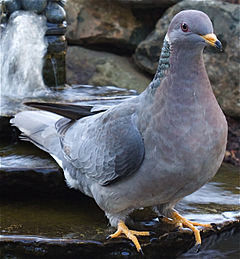- Band-tailed Pigeon
-
Band-tailed Pigeon 
Conservation status Scientific classification Kingdom: Animalia Phylum: Chordata Class: Aves Order: Columbiformes Family: Columbidae Genus: Patagioenas Species: P. fasciata Binomial name Patagioenas fasciata
(Say, 1823)Synonyms Columba fasciata Say, 1823
The Band-tailed Pigeon, Patagioenas fasciata,[2] is a medium-sized bird of the Americas. Its closest relatives are the Chilean Pigeon and the Ring-tailed Pigeon, which form a clade of Patagioenas with a terminal tail band and iridescent plumage on their necks.(Johnson et al., 2001)
It ranges from British Columbia, Utah, and Colorado south in higher elevations through Mexico and Central America to northern Argentina. In autumn it migrates out of the part of its range north of California, New Mexico, and west Texas. Populations from Costa Rica south are sometimes considered a separate species, the White-naped Pigeon, P. albilinea. It is found at altitudes from 900 to 3,600 m (3,000 to 12,000 ft), generally in oak, pine-oak, and coniferous forests. It feeds on seeds, notably acorns.
Contents
Morphology
It is the biggest pigeon in North America, measuring 33 to 40 cm (13 to 16 in) long and weighing 225–515 g (7.9–18.2 oz).[3][4] The coastal subspecies (averaging 392 g (13.8 oz)) is (P. f. monilis) is larger than the inland subspecies (averaging 340 g (12 oz)).[3] The plumage is gray, somewhat darker above. The head and underparts have a faint pink cast, especially in the adult male; the belly is nearly white. The distal half of the tail is also pale (except in the subspecies of Baja California), whence the English name. The bill and feet are yellow, good identification marks at sufficiently close range. Adults have green iridescence on the back of the neck, adjacent to a thin white collar on the nape. Juvenile birds have white feather edges above, giving a scaly appearance.
Behavior and ecology
This species is relatively quiet for a pigeon. Its voice is low-pitched and owl-like, often in two-syllable calls that rise and then fall (huu-ooh) with even spacing between calls.[5]
It builds a rudimentary platform nest out of twigs, in which it lays one or two eggs. Outside the breeding season it forms flocks, sometimes over 50 birds, and often becomes nomadic, following the acorn crop or moving to lower altitudes or other areas outside its breeding range. Toyon berries are a food consumed by the Band-tailed Pigeon.[6] This species often visits bird feeders.
The parasitic louse Columbicola extinctus, believed to have become extinct with the extinction of the Passenger Pigeon, was recently rediscovered on the Band-tailed Pigeon.
Line notes
References
- BirdLife International (2004) Database entry includes justification for why this species is of least concern
- Hogan, C. Michael (2008) Toyon (Heteromeles arbutifolia), GlobalTwitcher, ed. N. Stromberg [2]
- Howell, Steven N.G. & Webb, Sophie (1995): A Guide to the Birds of Mexico and Northern Central America. Oxford University Press, Oxford & New York. ISBN 0-19-854012-4
- Jiménez, Mariano II; Mariano G. Jiménez (2002–2003). "Paloma Encinera". Zoológico Electrónico. http://www.damisela.com/zoo/ave/otros/columb/columbidae/columba/fasciata/index.htm. Retrieved 2006-11-27. In Spanish.
- Johnson, Kevin P.; de Kort, Selvino; Dinwoodey, Karen, Mateman, A. C.; ten Cate, Carel; Lessells, C. M. & Clayton, Dale H. (2001): A molecular phylogeny of the dove genera Streptopelia and Columba. Auk 118(4): 874-887. PDF fulltext
- Mahler, Bettina & Tubaro, Pablo L. (2001): Relationship between song characters and morphology in New World pigeons. Biol. J. Linn. Soc. 74(4): 533–539. doi:10.1006/bijl.2001.0596 (HTML abstract)
- Sibley, David Allen (2000): The Sibley Guide to Birds. Alfred A. Knopf, New York. ISBN 0-679-45122-6
External links
- Band-tailed Pigeon videos on the Internet Bird Collection
- Aguilar Héctor F. La paloma torcaza o gargantilla 'Columba (fasciata)) fasciata Say 1823
Categories:- IUCN Red List least concern species
- Patagioenas
- Birds of Canada
- Birds of the United States
- Birds of Mexico
- Birds of Central America
- Birds of South America
- Birds of Trinidad and Tobago
Wikimedia Foundation. 2010.



